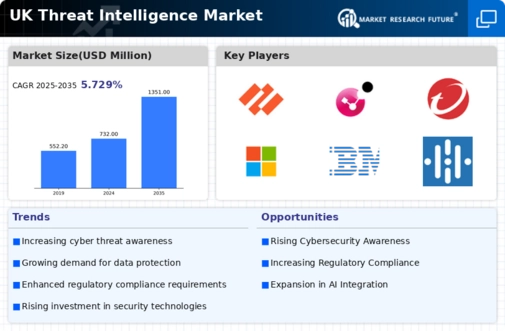The threat intelligence market is currently characterized by a dynamic competitive landscape, driven by the increasing sophistication of cyber threats and the growing demand for proactive security measures. Key players such as FireEye (US), CrowdStrike (US), and Palo Alto Networks (US) are at the forefront, each adopting distinct strategies to enhance their market positioning. FireEye (US) focuses on innovation through continuous development of its threat detection technologies, while CrowdStrike (US) emphasizes cloud-based solutions and AI-driven analytics to provide real-time threat intelligence. Palo Alto Networks (US) is strategically expanding its portfolio through acquisitions, enhancing its capabilities in endpoint protection and network security, thereby shaping a competitive environment that prioritizes advanced technological solutions and comprehensive service offerings.
In terms of business tactics, companies are increasingly localizing their operations to better serve regional markets, optimizing supply chains to enhance efficiency and responsiveness. The market appears moderately fragmented, with a mix of established players and emerging startups, each contributing to a diverse competitive structure. The collective influence of these key players fosters an environment where innovation and strategic partnerships are paramount, allowing for a more resilient and adaptive market.
In October 2025, FireEye (US) announced a strategic partnership with a leading cloud service provider to enhance its threat intelligence capabilities. This collaboration is expected to leverage cloud infrastructure to improve data analytics and threat response times, positioning FireEye (US) as a more agile player in the market. The significance of this partnership lies in its potential to streamline operations and provide clients with more robust security solutions, thereby reinforcing FireEye's (US) competitive edge.
In September 2025, CrowdStrike (US) launched a new AI-driven threat intelligence platform aimed at small to medium-sized enterprises (SMEs). This initiative reflects a strategic move to capture a broader market segment, addressing the unique security challenges faced by SMEs. By offering tailored solutions, CrowdStrike (US) not only expands its customer base but also enhances its reputation as a leader in accessible cybersecurity solutions, which could lead to increased market share.
In August 2025, Palo Alto Networks (US) completed the acquisition of a cybersecurity startup specializing in machine learning algorithms for threat detection. This acquisition is strategically important as it allows Palo Alto Networks (US) to integrate advanced machine learning capabilities into its existing products, thereby enhancing its competitive positioning. The move underscores a trend towards leveraging cutting-edge technology to stay ahead of evolving cyber threats, which is crucial in maintaining market leadership.
As of November 2025, the competitive trends in the threat intelligence market are increasingly defined by digitalization, AI integration, and a focus on sustainability. Strategic alliances are becoming more prevalent, as companies recognize the value of collaboration in enhancing their technological capabilities and market reach. Looking ahead, competitive differentiation is likely to evolve from traditional price-based competition to a focus on innovation, technological advancement, and supply chain reliability. This shift suggests that companies that prioritize these aspects will be better positioned to thrive in an increasingly complex and competitive landscape.




















Leave a Comment